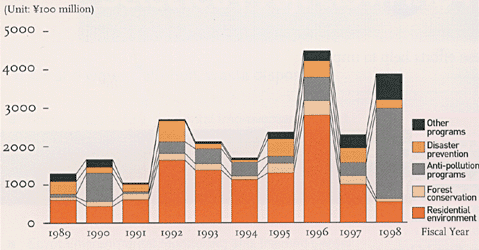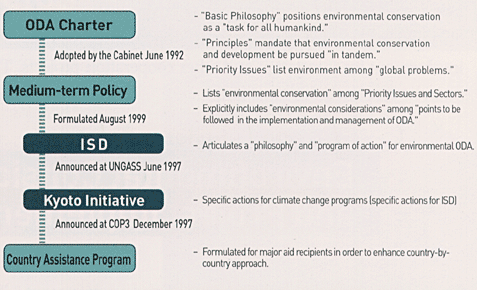Official Development Assistance (ODA)
Japan's Environmental Cooperation
Japan's Environmental Cooperation

Latin American city hidden in smog by an inversion layer (100-150 meters in the air).
The ODA Charter formally adopted by the Cabinet in June 1992 includes environmental conservation as a basic philosophy underlying Japanese aid; its principles mandate that aid be implemented in a manner that addresses both environmental and developmental concerns. The Medium-term Policy on ODA published in August 1999 also lists environmental conservation as a priority task.
Japan began to bolster its environmental cooperation in the early nineties. Environmental cooperation today follows the Initiatives for Sustainable Development toward the 21st Century (ISD) announced in June 1997 at the Special Session of the United Nations General Assembly for the Overall Review and Appraisal of the Implementation of Agenda 21 (UNGASS).
During the Third Conference of the Parties to the United Nations Framework Convention on Climate Change (COP3) held in Kyoto in December 1997, the Kyoto Initiative on aid for global-warming programs in developing countries was announced by Japan. This initiative aims at assisting developing countries in taking steps during the development process to deal with the global warming issue, which threatens sustainable development on a worldwide scale. Under the Initiative, Japan provides active support for global warming programs in addition to traditional environmental programs.
Environmental ODA results

Environmental conservation within the Japanese ODA framework

Philosophy of ISD
- Human Security:
- Environmental degradation threatens the human existence, and constitutes a security issue in a broad sense.
- Ownership:
- Developing countries assume the primary responsibility and roles to address environmental issues. Donor countries assist such self-help efforts.
- Sustainable Development:
- The objective of environmental cooperation should be to realize sustainable development, paying attention to the different economic and social situation of each developing country.
